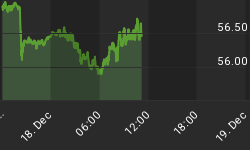Whoever is selling stocks these days is really appreciative of those who are pushing the market higher. Thanks to overnight rallies in China and Japan on Tuesday night, US stocks launched higher at the open on Wednesday. Now, neither the modest rally in Shanghai (led by official buying) and the bigger rally in Japan (on Prime Minister Abe's pledge to cut corporate taxes next year) had the slightest thing to do with items that impact the US, but the rally led a wave that rolled through futures markets around the globe until about seven minutes after traditional stock trading hours opened in New York, when the high of the day was set. The next six-and-a-half hours saw a 440-point decline in the Dow and around 50 in the S&P to a net loss of about 1.4% on the day.
"Gee, thanks!" said the pension fund guys who got to unload stocks about 3% higher than they otherwise would have. Who says the fast money monkeys don't have salutatory effects?
The clue that today's rally was not going to be sustained was actually in the energy markets. Prior equity oscillations had been mirrored with quite reasonable fidelity in the last week or two, but this morning energy markets were noticeably flat-to-down. Equities soon joined them.
Now, yesterday I mentioned that real yields are near their highest levels of the last five years, and that nominal yields are essentially in the middle of that range. I didn't illustrate the latter point; but see below (source: Bloomberg).

So it is clear, to me, where you would rather place your bets in fixed-income: with real yields around 65bps and nominal yields at 2.20, you only want to own nominal bonds if inflation is less than 1.55% for ten years. Note that if inflation is negative, then you do approximately the same with TIPS as with nominal bonds, since in both cases your nominal principal is preserved. So it is a narrow set of circumstances in which you do better owning nominals, and you don't do much better. On the other hand, there are long tails on the other side: ways that by owning TIPS you will do dramatically better.
I mention this, even though both nominal bonds and TIPS offer poor prospective returns, because it is the time of year when seasonally it is difficult to lose by owning fixed-income. The chart below (source: Bloomberg) shows the average change in nominal 10-year yields over the course of a calendar year for the last 30 years (gold), 10 years (white), and 5 years (red). Note that this isn't a pure seasonal chart because it doesn't correct for the average drift over the course of the year, but it suffices to show that buying bonds after the early-September backup has been a good strategy for many years...really, until the last five years, and even then it was a push between mid-Sep and mid-Nov.

So what I want to do in a period of uncertainty, headed into the fourth quarter, is to own TIPS, either outright or via an ETF like TIP. If the market comes unglued, then all interest rates should decline; if the market drops because real growth is weakening, then real rates should fall more than nominal rates (and in any event, owning TIPS gives you the positive tail exposure I mentioned above). If the market turns around and rallies, then energy probably recovers somewhat and this will help TIPS compared to nominals. But in any event, I am reducing risk into a very risky period.
You can follow me @inflation_guy!
Enduring Investments is a registered investment adviser that specializes in solving inflation-related problems. Fill out the contact form at http://www.EnduringInvestments.com/contact and we will send you our latest Quarterly Inflation Outlook. And if you make sure to put your physical mailing address in the "comment" section of the contact form, we will also send you a copy of Michael Ashton's book "Maestro, My Ass!"















